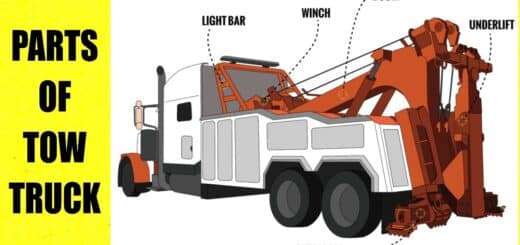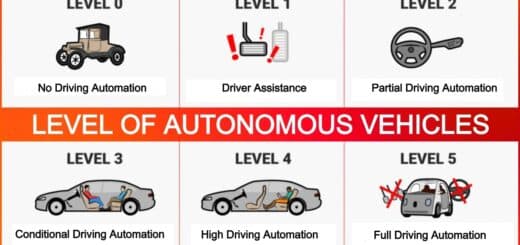17 Parts of Semi-Truck and Their Uses [with Pictures & Names]
![17 Parts of Semi-Truck and Their Uses [with Pictures & Names]](https://engineeringlearn.com/wp-content/uploads/2023/05/Parts-of-Semi-Truck-1024x539.jpg)
Introduction
17 Parts of Semi-Truck and Their Uses [with Pictures & Names]: – The diesel engine is the primary source of power for semi-trucks. A few fleets have opted for natural gas sources like LNG, yet it doesn’t have a similar level of infrastructure built to accommodate repairs and fueling. Despite engine type, all engines built in the present time are computer controlled. If your truck is to be safe and secure for the road, for you as well as for other road users, regular maintenance is surely required and a service like once a year must be carried out.
What is a Semi-Truck?
Semi-trucks are liable for moving a large part of the country’s cargo, making them a fundamental part of the supply chain and regular living. A semi-truck, otherwise called a semi-trailer truck, is the combination of a tractor unit and at least one semi-trailer to carry cargo. The result is that both the tractor and semi-trailer will have a design particularly not equivalent to that of a rigid truck and trailer.
Semi-trucks are very mind-boggling and complex tools that perform or play a critical part in the transportation and distribution of goods to different parts of the country. In that, each part of the truck should work in tandem to reach the destination at every objective and complete the job. Yet, one could consider which parts go into assembling a semi-truck and what compels them the only vehicles that can achieve these tasks. These are the different parts of a semi-truck and how they capability together.
Parts of Semi-Truck
- Distance Variations
- Wheels and Tires
- Brakes
- Electrical System
- Lights
- Mirrors
- Seats
- Torque Converters
- Transmissions
- Drive Shafts
- Clutches
- Axles
- Air Brakes
- Steering Components
- Chassis Frame
- Fifth Wheel
- Heating, Ventilation, Air Conditioning
1. Distance Variations: ( Parts of Semi-Truck )
There are specific or explicit names and terms given to distances between specific parts of a semi-truck. Below we discuss one by one:-
- Trailer-length – The overall general semi-trailer length. This is normally 48FT or 53FT.
- Wheelbase – The distance between the center of the steer and drive axles.
- Landing gear clearance – The landing gear clearance is the center point to the closest point of interference.
- Overall wheelbase – The wheelbase between the center line of the steer axle and the rearmost axle of the trailer.
- Kingpin setting – The front of the semi-trailer to the center of the kingpin on the semi-trailer.
2. Wheels and Tires: ( Parts of Semi-Truck )
Dented or damaged rims can prompt tire failures, as can inappropriate inflation or wear from driving on tires past their useful tread life. We’ve all seen the leftovers of blown-out truck tires in the street. Experienced drivers of semi-truck realize that putting resources into quality tires takes care of over the long haul. Holding back on tires can bring about expensive mishaps. In the worst situation, tire failure can make a driver lose control completely,, fishtail, or roll, potentially slamming into different vehicles, hindrances, or trees.
3. Brakes: ( Parts of Semi-Truck )
Semi-trucks are enormous and to overcome inertia they require heavy-duty brakes. A body in motion will in general remain in motion except if that’s what an external power changes. Semi-truck brakes need maintenance and replacements more every now and again than passenger cars. Present-day truck brakes are complex systems of drums, brake pads, discs, springs, and compressed air that work together to connect with and disengage the mechanism that stops the vehicle. All parts ought to be checked consistently for wear. On account of air brakes, drivers ought to check for leaks that reduce or lessen the braking mechanism’s effectiveness.
4. Electrical System: ( Parts of Semi-Truck )
The truck’s electrical systems mainly comprised of batteries, an alternator, and a starter that should be as per the requirements of the engine. Without an electrical system, certain features of the truck wouldn’t work including the starter, lighting, windshield wiper engines, computer system activity, and the cabin conveniences like a power inverter.
5. Lights: ( Parts of Semi-Truck )
Twilight isn’t an ideal time to discover your lights aren’t working. This goes for a semi-trucks headlights yet in addition brake lights, backlight, and some other lights are required to enlighten the truck’s exterior for other drivers’ visibility. Stick with the truck manufacturer’s suggestions in regard to what sort of lights to install when replacements become essential.
6. Mirrors: ( Parts of Semi-Truck )
That’s what most drivers discover in the event that they can’t see a truck’s mirrors, the trucker can’t see them. Mirrors are among the main part of a semi-truck. A good set of mirrors that gives a reasonable view of lanes on one or the other side of the truck is critical for the safety of the truck. Lane changes and reversing depend on mirrors to give drivers notice of obstructions and different vehicles. Clean mirrors are essential for truckers, and cleaning them on a routine basis can save a lot of lives.
7. Seats: ( Parts of Semi-Truck )
Commuters in passenger vehicles understand the significance of a comfortable seat. Presently increase that by an extra 8-10 hours in the driver’s seat, and you’ll comprehend how critical a supportive, comfortable truck seat is too proficient truckers. A good seat is an adjustable front and toward the back, up and down, and reclinable. Truckers can be passionate about their seats, and many pick post-retail semi-truck seats with extra features like cooling, heating, or adjustable arm sets.
8. Torque Converters: ( Parts of Semi-Truck )
Torque converters are found in completely programmed transmissions, for example, the ones made by Alison. It resembles a clutch for manual trucks however works in another way. Torque converters are also named fluid couplings since they use hydrodynamics.
9. Transmissions: ( Parts of Semi-Truck )
Heavy-duty truck transmissions are manual, automated, or mechanized manual, as well as automatic. Different parts of the transmission should give better execution for a thousand miles or more. Manual transmissions have a few counter-shafts that transmit engine torque from the input to the output shaft.
The counter-shafts distribute torque to a few bearings, and this outcome in reduced strain on individual gears. Automated or Mechanized manual transmissions don’t have a clutch pedal on the grounds that the clutch is impelled automatically.
10. Drive Shafts: ( Parts of Semi-Truck )
The driveshaft is a tube with flanges or end yoke that is joined with the output shaft of the transmission and it assists with mobility of the drive axles. Parts of the drive shaft are interconnected with one another and with the transmission with universal joints which permit torque to transmit.
11. Clutches: ( Parts of Semi-Truck )
Most semi-trucks have a push or pull clutch. A few trucks have centrifugal or wet clutches. Trucks with higher torque evaluations have a two-plate clutch. The reason or justification for a two-plate clutch is to expand the area of friction and transmit it to the transmission with zero slippage. Automated manual transmission semi-trucks have clutches that are managed electronically.
12. Axles: ( Parts of Semi-Truck )
An axle on your truck is a rod or shaft that rotates or turns the wheels and the truck’s weight. The drive axles have differential gear shafts which assist truckers in the snow with keeping their truck from sliding. Another name for the front axle is the steer axle.The back two axles are known as the drive axles.
13. Air Brakes: ( Parts of Semi-Truck )
Air brakes are the most well-known type of brake mechanism on a semi-truck. Air brakes utilize a complicated network of pneumatic lines, valves, and cylinder that maintain or keep up with the transfer of compressed air to the brakes.
14. Steering Components: ( Parts of Semi-Truck )
Two main kinds of steering systems are found in semi-trucks. They are manual and power steering assist systems. Manual steering systems have worm roller or recycling ball gears. Power steering assist utilizes a hydraulic pump. Rack and pinion steering are found in newer semi-trucks that provide better control.
15. Chassis Frame: ( Parts of Semi-Truck )
The chassis frame includes the rails and cross-members of the truck and the strength of these parts impacts the truck’s durability to carry heavy loads.
16. Fifth Wheel: ( Parts of Semi-Truck )
The fifth wheel is the part of a semi-truck that connects or interfaces to the kingpin of the trailer. The kind of connection formed between the coupling of the fifth wheel permit the truck to articulate while turning. Fifth wheels can be positioned or slide in reverse and forward to permit proper distribution of the trailer weight on the drive axles of the semi-truck.
17. Heating, Ventilation, Air Conditioning (HVAC): ( Parts of Semi-Truck )
HVAC systems are responsible and liable for the environment control of the semi-truck unit. Some HVAC systems are combined with auxiliary systems that assist balance the in-cabin temperature with engine temperature and engine shutdown features to forestall overheating. Anti-idling regulations are making an increased requirement for sophisticated HVAC systems. For instance, the development of parking radiators has helped with keeping trucks from idling for extended time frames.
Conclusion
Trucking has become super advanced with required electronic logging devices (ELD) and GPS systems. Semi-trucks are really buckling down out and about every day of the week, generally traveling hundreds and even thousand of miles in a given week. With all this hard work and such a significant task to take care of, it’s a good idea that numerous semi-truck parts will require maintenance so they can continue to perform. These safety measures record long periods of service to forestall driver fatigue and pinpoint the truck’s location, which could be critical in a crisis. Above mentioned are important parts of a semi-truck, however, numerous others are things all drivers should maintain on their vehicles.
Image Source: – cagtruckcapital












